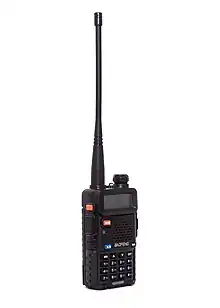Baofeng UV-5R
The Baofeng UV-5R is a hand held radio manufactured by the Chinese manufacturer BaoFeng. This model was the first worldwide successful distributed dual band radio (VHF/UHF) of a Chinese brand. It is inexpensive and relatively simple in use, because of this it is used by radio amateurs as well as professional users worldwide.[1][2]

| Baofeng UV-5R | |
|---|---|
| Technical Data | |
| Frequency range | 136–174 MHz 400–520 MHz |
| Frequency steps | 2.5–50k Hz |
| Transmitter power output | 5 W PEP |
| Waveforms (modulations) | FM |
| modulation rate | |
| Power input | Receiver only 20 mA, Transmitter 1 A max. |
| Operating voltage | 6.5 – 9 V, Nominal voltage 7.2 V |
| Measurements and Weight | |
| High | 140 mm |
| Width | 70 mm |
| Depth | 30 mm |
| Weight | ca. 400 Gramm |
| Further informations | |
| Producer | Baofeng |
| Scope of application | radio amateurs, (semi-) professional users |
History
The Baofeng UV-5R has been produced since 2012 and exported to markets worldwide. The radio had no FCC Part 95 certification[3] in the United States. As a result, it was not authorized for use in the GMRS and FRS, only for amateur radio.[4][5] Baofeng launched a number of other models based on the UV-5R technology, since 2012. Other radios from other Chinese manufacturers have mainly the same range of functions, specs and menu like the UV-5R, for example the Retevis RT5.[6]
The UV-5R has attracted the attention of multiple telecommunications regulators due to problems relating primarily to frequency interference, and is banned from sale and use in Switzerland, Germany, Poland and South Africa. The German Federal Network Agency has banned the device because it dampens harmonics too poorly and can therefore disturb other users.[7] The Independent Communications Authority of South Africa issued a ban after finding the UV-5R to be causing radio frequency interference, and for having continuous tuning capabilities; a feature that would require an operator Frequency allocation license before purchasing or using the device.[8]
Features
It is designed to transmit on the 2 meter band between 136 and 174 MHz (VHF) and on the 70 Centimeter-band between 400 and 520 MHz (UHF). Features include CTCSS, Digital coded squelch, 128 programming channels[9] and duplex operation for use with local repeaters, dual watch and dual reception, an LED flashlight, voice prompts in either English or Chinese and programmable LED lighting for the LCD display.[10][11]
Programming channels and frequencies by hand is harder and cumbersome. Programming via a computer is much easier using the CHIRP application and a specific USB to radio cable.
References
- Joe (2020-03-02). "5 Best BaoFeng Two Way Radios (Reviews Updated 2022)". CW Touch Keyer. Archived from the original on 2022-06-27. Retrieved 2022-07-16.
- Official, Tidradio |. "Great alternatives to the Baofeng UV-5R". Tidradio | Official. Retrieved 2022-07-16.
- "New FCC Part 95 Personal Radio Services Rules Published in The Federal Register". www.arrl.org. Retrieved 2022-07-21.
- "FCC Cites Baofeng Importer for Illegally Marketing Unauthorized RF Devices". www.arrl.org. Retrieved 2022-07-16.
- "10 Best Baofeng Radio Reviews 2022 – Buying Guide". PalmGear. Retrieved 2022-07-16.
- AmazonUS (2018-11-15). "The difference between Retevis RT5 and BfUV-5R". Two Way Radio Community. Retrieved 2022-07-16.
- https://www.radiobunker.de/archive/1458?v=3a52f3c22ed6
- "Notice to prohibit the usage and sale of BAOFENG, Model Number: UV-5R – Independent Communications Authority of South Africa". www.icasa.org.za. Retrieved 2023-08-25.
- "Best Bug Out Radio". Retrieved 2022-07-16.
- Résilient, Le (2019-02-03). "BaoFeng UV-5R – Prise en main et configuration". La résilience (in French). Retrieved 2022-07-16.
- JR (2018-06-05). "List of Common Radio Frequencies for the Baofeng UV-5R". 1776PatriotUSA.com. Retrieved 2022-07-16.